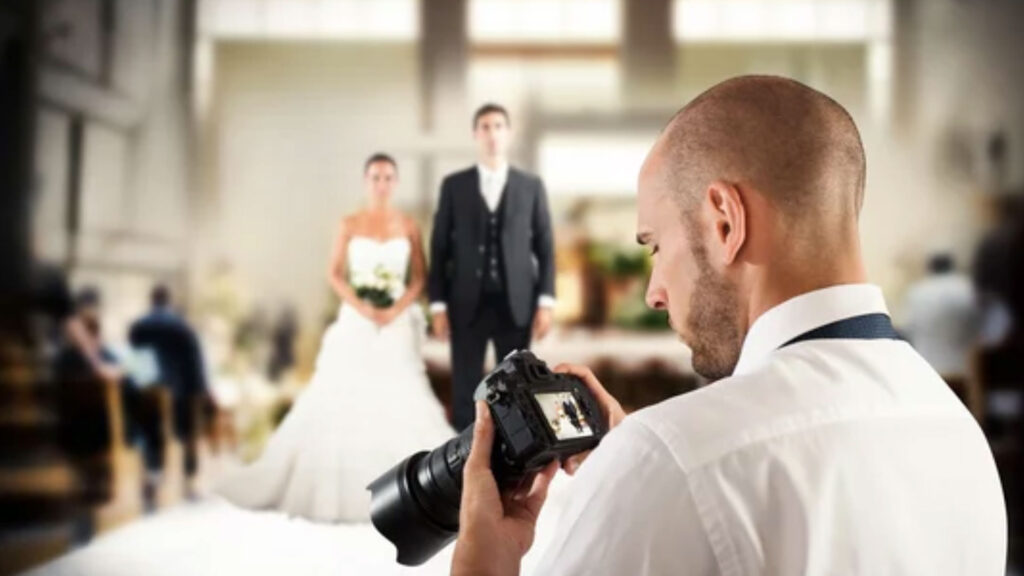When deciding between physical photo albums and digital galleries for their wedding photos/videos, couples should consider the following factors:
- Accessibility and sharing: Couples should think about how they want to share their wedding photos/videos with family and friends. Physical photo albums offer a tangible and personal experience, allowing individuals to flip through pages and enjoy the printed photographs. On the other hand, digital galleries provide easy accessibility, enabling couples to share their photos/videos instantly with a larger audience through online platforms or social media.
- Longevity and preservation: Reflecting on the long-term preservation of their wedding memories is essential. Physical picture albums, if properly cared for, may endure throughout time and be passed down through generations as treasured gifts for them. Conversely, digital galleries rely on technology, which can change rapidly. Couples should consider backup strategies, file formats, and the possibility of data loss or obsolescence when choosing a digital medium.
- Experience and emotional connection: Couples should think about the type of experience and emotional connection they desire from their wedding photos/videos. Physical photo albums allow for a tactile and nostalgic experience, providing a tangible connection to the memories captured. On the other hand, digital galleries offer the convenience of instant access, easy organization, and the ability to view photos/videos on various devices.
- Customization and personalization: Physical photo albums offer opportunities for customization, such as selecting specific layouts, materials, covers, and design elements that align with the couple’s style and preferences. Digital galleries, on the other hand, may provide options for creating personalized slideshows, adding music, or incorporating interactive elements that enhance the viewing experience.
- Cost considerations: Couples should factor in the cost associated with physical photo albums and digital galleries. Physical albums involve expenses such as printing, binding, and potentially professional album design services. Digital galleries may require subscription fees for online storage or hosting platforms. Evaluating budget constraints alongside the desired outcome can help couples make an informed decision.

What are the potential positive consequences and adverse consequences of physical photo albums compared to digital galleries when it comes to preserving and sharing wedding photos/videos?
Advantages of physical photo albums for preserving and sharing wedding photos/videos:
- Tangible and sentimental value: Physical photo albums provide a tangible and tactile experience, allowing couples to flip through the pages and relive the memories of their wedding day. The physical presence of the album creates a sentimental connection and can be passed down as a cherished heirloom.
- Longevity: Well-crafted physical albums can withstand the test of time and preserve the photos/videos for future generations. They are not subject to technological changes or digital obsolescence, ensuring that the memories remain accessible in their original form.
- Nostalgic experience: The process of flipping through physical photo albums evokes a sense of nostalgia and allows couples to reminisce about their special day in a more intimate and tactile manner. It can create a deeper emotional connection to the photos/videos.
Disadvantages of physical photo albums for preserving and sharing wedding photos/videos:
- Limited accessibility: Physical photo albums require physical presence to view and share with others. They may be inaccessible to distant relatives and friends, as well as those who are unable to visit in person. Sharing photos/videos with a bigger audience might be more difficult.
- Limited storage capacity: Physical albums have limited space for photos/videos, and adding or removing pages can be difficult. Couples may need to carefully curate their selection of images, potentially leaving out certain moments they would have liked to include.
Advantages of digital galleries for preserving and sharing wedding photos/videos:
- Easy accessibility: Digital galleries offer instant access to the wedding photos/videos from anywhere with an internet connection. Couples can easily share the gallery with family and friends, allowing them to view and download the images/videos at their convenience.
- Wide sharing options: Digital galleries enable couples to share their wedding photos/videos on various platforms, such as social media, email, or private online galleries. This would make it easier to reach a larger audience and share the memories with loved ones who couldn’t attend the wedding.
- Flexible storage and organization: Digital galleries provide virtually unlimited storage capacity, allowing couples to store all their wedding photos/videos in one place. They can also easily organize and categorize the images/videos, making it simple to locate specific moments or create custom slideshows.
Disadvantages of digital galleries for preserving and sharing wedding photos/videos:
- Reliance on technology: Digital galleries rely on technology for access and preservation. Changes in technology or the loss of data due to hardware failure, software incompatibility, or data breaches can put the photos/videos at risk. Adequate backup strategies and file management are crucial.
- Potential for distraction: In the digital realm, photos/videos can easily get lost among countless other digital files and distractions. The viewing experience may be less focused, and the emotional impact of the images/videos may be diluted in comparison to the tactile and intimate experience of physical photo albums.

How do physical photo albums and digital galleries differ in terms of accessibility and convenience for couples and their loved ones to view and enjoy the wedding photos/videos?
Physical photo albums and digital galleries differ in terms of accessibility and convenience for couples and their loved ones to view and enjoy wedding photos/videos. Here’s how they compare:
Physical photo albums:
- Accessibility: Physical photo albums require physical presence to view and enjoy the wedding photos/videos. They need to be physically opened and flipped through, limiting accessibility for those who are not physically present or live far away.
- Intimate experience: Physical photo albums offer a tactile and intimate experience. Couples and their loved ones can hold the album, turn the pages, and immerse themselves in the memories captured in the printed photographs.
- Limited sharing options: Sharing physical photo albums can be more challenging. Couples may need to physically pass the album to others or make copies of the photos, which can be time-consuming and costly.
- Offline access: Physical photo albums do not require an internet connection or specific devices to view the photos/videos. They can be enjoyed even in environments without technology or where internet access is limited.
Digital galleries:
- Convenient accessibility: Digital galleries provide instant access to wedding photos/videos from anywhere with an internet connection. Couples and their loved ones can access the gallery on various devices, such as smartphones, tablets, or computers, making it easy to view the photos/videos at any time and from any location.
- Wide sharing options: Digital galleries offer a range of sharing options. Couples can share the gallery with family and friends through email, social media platforms, or private online galleries. This allows for quick and widespread distribution, reaching a larger audience, regardless of geographical distance.
- Online and interactive experience: Digital galleries often provide additional interactive features. Slideshows, image zooming, commenting, or liking functionalities can enhance the viewing experience and facilitate engagement with the wedding photos/videos.
- Potential dependency on technology: Digital galleries require access to the internet and specific devices to view the photos/videos. The reliance on technology means that technical issues, internet connectivity problems, or device compatibility can temporarily hinder the accessibility or convenience of viewing the photos/videos.
What factors should couples take into account when considering the longevity and preservation of their wedding photos/videos in physical photo albums versus digital galleries?
When considering the longevity and preservation of wedding photos/videos in physical photo albums versus digital galleries, couples should take several factors into account:
Physical photo albums:
- Material quality: Couples should consider the quality of materials used in the physical photo albums. High-quality albums made with archival-grade materials are more likely to withstand the test of time, preserving the photos/videos for future generations.
- Environmental conditions: The storage conditions of physical photo albums play a crucial role in their longevity. Couples should ensure that albums are kept in a cool, dry, and stable environment to prevent damage from moisture, heat, or exposure to direct sunlight.
- Handling and care: Proper handling and care are essential for preserving physical photo albums. Couples should minimize excessive handling, avoid touching the photos directly, and use clean hands when interacting with the album. Additionally, they can consider protective measures such as acid-free sleeves or gloves to further safeguard the photos/videos.
- Storage space: Physical photo albums require physical storage space, so couples should consider the availability of adequate storage solutions to protect the albums from physical damage, such as dust, moisture, or accidental mishaps.
Digital galleries:
- Backup strategies: Digital galleries rely on technology, which can be susceptible to data loss or technical failures. Couples should implement robust backup strategies to protect their wedding photos/videos. This includes creating multiple backups stored in different locations or utilizing cloud-based storage solutions.
- File formats and compatibility: Choosing a widely supported and durable file format for digital files is crucial to ensure long-term accessibility. Couples should consider formats that are likely to be compatible with future technology and software updates.
- Data migration: As technology advances, couples should be prepared to migrate their digital files to newer storage solutions or formats. Regularly transferring and updating their wedding photos/videos to current storage technologies can help prevent data loss due to outdated or incompatible systems.
- Data security and privacy: Digital galleries may require couples to store their photos/videos online or on third-party platforms. It is essential to consider data security and privacy measures, including password protection, encryption, and choosing reputable and secure platforms for hosting the digital gallery.
By considering these factors, couples can make informed decisions regarding the longevity and preservation of their wedding photos/videos. They can choose the option that aligns best with their preferences, the desired lifespan of the memories captured, and their comfort level with technology.





